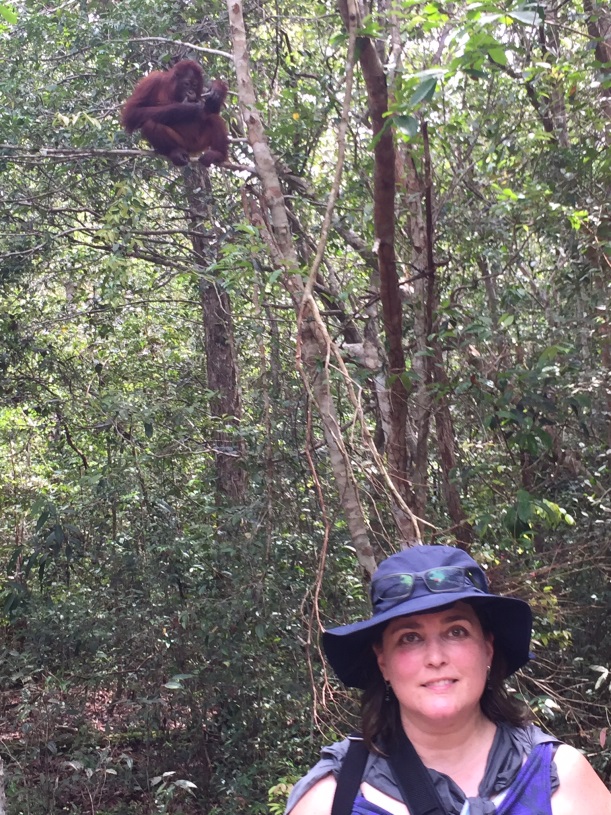
Shannon and her family visited Camp Leakey in Borneo, Indonesia where she met with Dr. Biruté Galdikas to learn about her lifelong work in orangutan and rainforest habitat preservation in December 2015.
In Celebration of Earth Day, we’re learning more about the Port’s Environmental Management System (EMS). The EMS goes beyond regulatory requirements through evaluation and control of impacts and continual improvement. The “Plan-Do-Check-Act” cycle ensures ongoing performance enhancement, and Environmental Affairs Program Manager Shannon Tocchini ensures detail and excellence are applied at every step of the EMS process!
In November 2014, the Port’s EMS was certified by an independent third-party to the ISO 14001:2004 standard. The independent third-party auditors reported that, “This EMS is the most comprehensive, advanced and effective to be audited by this audit team with a combined 38 years of experience auditing to the ISO 14001 standard.”
Describe your educational and professional background.
I graduated from University of Oregon with a double major in international studies and political science. Keeping a very diverse schedule, I was only a few credits away from also achieving a fine arts degree.
After college, I worked for a multinational manufacturing corporation in export sales, soon transitioning to a corporate environmental focus. While at that company, I developed a waste minimization program, energy use tracking, carbon footprint accounting, and played a key role in developing an environmental management system. I also developed the systems for tracking and reporting environmental performance and played a lead role in developing and publishing several GRI-aligned sustainability performance reports.
Mid-career, I completed a masters of business administration and numerous graduate level courses in industrial ecology, environmental management and sustainability. A highlight was participating in the Multi-State Working Group on Environmental Performance – a group that brought together regulators, businesses and non-government organizations from across North America to improve environmental performance through strategic use of an EMS. I spent a few years as the corporate sustainability manager for a large engineering and architecture firm before coming to work at the Port. In all, this represents more than 20 years of work in the area of environmental management and sustainability.
What drew your interest in a Science, Technology, Engineering, Math (STEM) career?
The concept of waste – the level of waste we have in our society and around the world – really doesn’t make much sense. There is a significant cost, even if it isn’t well accounted for in dollars. I see opportunity to think systematically and efficiently by improving designs and processes that eliminate waste. I constantly ask how can we do better? The opportunity to make positive change is invigorating!
Describe some of your primary projects at the Port.
My primary responsibility is to build on and continuously improve the Port’s EMS in conformance with the ISO 14001 international standard, for which we are certified to and monitored on annually. Working with operations and environmental subject matter experts, I ensure we have procedures and practices in place to meet legal requirements and our environmental commitments to the community, while fostering continuous improvement. This includes developing policy and procedures; maintaining communication and data management tools; tracking and reporting performance; training development and delivery; and auditing. I’m also working on triple-bottom-line sustainability integration, so I’m thinking about how to build equity and stakeholder involvement into EMS tracking with our Port team.
What innovative trends do you see in your field?
Biomimicry intrigues me – what can we learn from nature to improve our designs and processes? Where and how can biomimicry inform system designs? I participated in a workshop in Tambopata National Reserve in Peru led by Janine Benyus and Dayna Baumeister, founders of Biomimicry Institute, where we studied nature and ways it solves “problems” for insights on designing systems and products symbiotic with the environment.
In the last decade, universities have developed degrees and certification programs that emphasize sustainability – such as green masters in business degrees. Really, opportunities abound to incorporate sustainability into every role and field of work. Eventually, we’ll get to the point where degrees don’t need to highlight “sustainability,” it will just be expected, integrated and intrinsic. The same goes for workplace roles. The Port is already working on this – integrating triple-bottom-line thinking into our processes and culture.
What “green tips” would you give to fellow Oregonians?
Consumption drives a great deal of pollution and waste. Understanding where products come from and associated trade-offs is important. In my view, we vote with our dollars when we shop – meaning we are endorsing the processes, labor practices and environmental impacts that get that product (or service) to us.
Admittedly, my “votes” are far from perfect. Thinking about this for every purchase can be difficult, mind boggling and frankly a little depressing, but learning about and supporting good products, services and organizations, and rethinking, reusing and recycling helps create a more sustainable society. Borrowing from the Port’s EMS tagline, less waste does equal more world.
PORTraits in Sustainability is an occasional series in which we profile the people who make the difference in applying sustainability to organizational performance.
